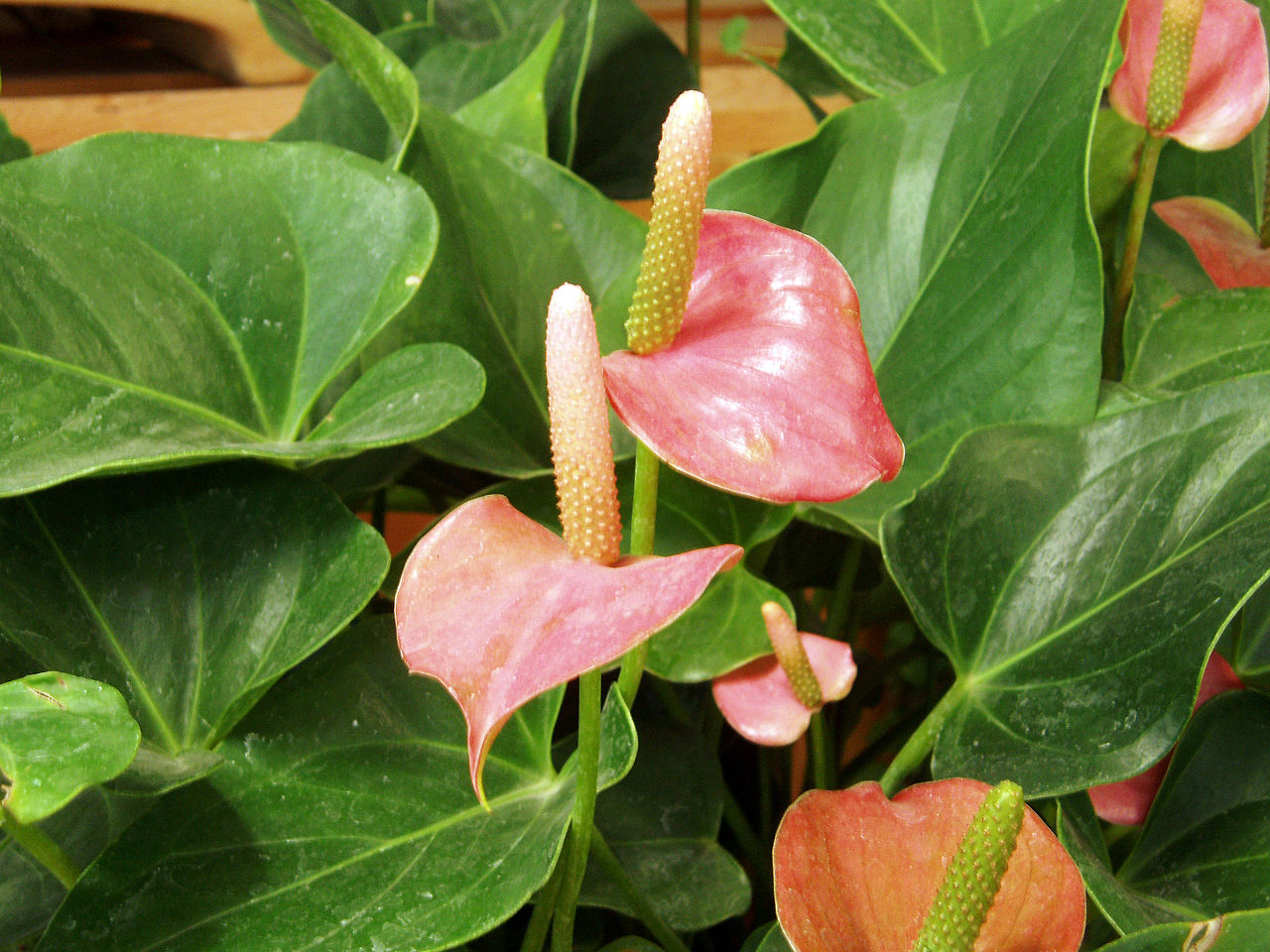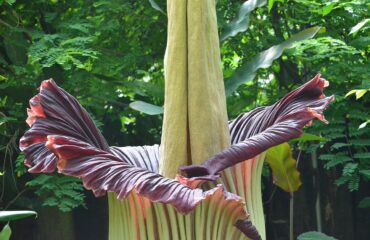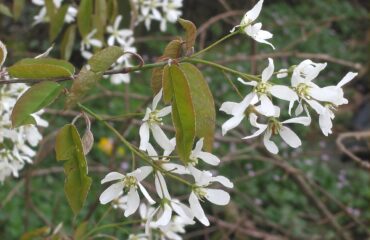Anthurium andraeanum, commonly known as Flamingo Flower or Laceleaf, is a striking tropical perennial native to Colombia and Ecuador. It is highly valued for its glossy, heart-shaped leaves and vibrant, long-lasting spathes, which can be red, pink, white, or even green. The spathes are often mistaken for flowers but are actually modified leaves that surround a spadix, which bears the true flowers. Flamingo Flowers are popular as houseplants and in floral arrangements due to their exotic appearance and ability to bloom throughout the year under optimal conditions.
Preferred Growing Conditions:
- Soil Type: Prefers a well-draining, organic-rich potting mix; thrives in a mixture of peat, pine bark, and perlite or orchid mix.
- Sunlight: Grows best in bright, indirect light; can tolerate lower light levels but may produce fewer flowers.
- Temperature: Hardy in USDA zones 10-11; prefers warm, humid conditions with temperatures between 65-80°F (18-27°C).
- Water Needs: Moderate to high; requires regular watering to keep the soil consistently moist but not waterlogged.
Anthurium Andraeanum (Flamingo Flower) Propagation Methods:
1. Division:
Division is the most common and effective method for propagating Anthurium andraeanum, particularly for established plants. This method helps rejuvenate the parent plant and produce new plants with identical characteristics.
- Timing:
- The best time for division is in spring or early summer when the plant is actively growing.
- Method:
- Carefully remove the plant from its pot and gently shake off excess soil to expose the root system.
- Use a clean, sharp knife to divide the root ball into smaller sections, ensuring each division has at least one growing point and a portion of the root system.
- Remove any dead or damaged roots and foliage.
- Replanting:
- Replant the divisions immediately in prepared pots filled with a well-draining, organic-rich potting mix.
- Plant at the same depth as the original plant, ensuring the roots are covered but the growing point is just above the soil level.
- Water thoroughly to settle the soil around the roots.
- Care After Division:
- Keep the newly planted divisions in a warm, humid environment with bright, indirect light.
- Maintain consistent moisture by watering regularly, but avoid waterlogging.
- Protect from strong drafts and sudden temperature changes during the initial recovery period.
2. Stem Cuttings:
Propagating Anthurium andraeanum from stem cuttings is another reliable method, especially during the growing season. This method is particularly useful for plants with long, healthy stems.
- Types of Cuttings:
- Use stem sections with at least one node and a few aerial roots, taken in late spring or early summer.
- Preparation:
- Cut 4-6 inch sections from the stem just below a node, ensuring each section has at least one aerial root.
- Allow the cut ends to dry and callous over for a few hours before planting to prevent rot.
- Planting:
- Insert the cuttings into a well-draining potting mix, such as a blend of peat, pine bark, and perlite or an orchid mix.
- Place the cuttings so that the nodes are buried and the aerial roots are in contact with the soil.
- Water lightly and cover the pot with a plastic bag or place in a propagation tray with a clear lid to maintain humidity.
- Place in a bright, indirect light location.
- Rooting:
- Roots should begin to form within 4-6 weeks.
- Once roots are established and new growth appears, gradually acclimate the cuttings to lower humidity.
- Transplant the rooted cuttings into individual pots or larger containers as they grow.
3. Seed Propagation:
Growing Anthurium andraeanum from seeds is possible but less common due to the difficulty of obtaining seeds and the long time required for seedlings to reach maturity.
- Seed Collection and Preparation:
- Collect seeds from mature spadices once the berries have ripened and turned soft.
- Clean the seeds by removing the pulp and rinsing them thoroughly.
- Seeds should be sown fresh for best results, as they have a short viability period.
- Sowing Techniques:
- Fill seed trays or small pots with a light, well-draining seed-starting mix.
- Sow the seeds on the surface of the soil and lightly press them in without covering, as they require light for germination.
- Mist the surface lightly and cover with a clear plastic lid or plastic wrap to maintain humidity.
- Place the trays in a bright location with temperatures around 75-85°F (24-29°C).
- Germination Requirements:
- Seeds typically germinate within 1-2 weeks under optimal conditions.
- Remove the cover once seedlings emerge to provide better air circulation.
- Keep the soil slightly moist and provide bright, indirect light to prevent the seedlings from becoming leggy.
- Care for Seedlings:
- When seedlings have developed several true leaves and are sturdy enough to handle, transplant them into individual pots.
- Choose a well-draining, organic-rich potting mix and a warm, humid environment for the seedlings.
- Note that seed-grown plants may take several years to reach maturity and begin flowering.
4. Tissue Culture:
Tissue culture is an advanced propagation method used primarily in commercial settings to produce large numbers of uniform plants quickly. This method involves growing plant tissues in a sterile, controlled environment.
- Process:
- Small pieces of plant tissue, typically from the growing tips or meristem, are sterilized and placed in a nutrient-rich, sterile medium.
- Under controlled conditions, the tissue forms a callus, which then differentiates into shoots and roots.
- Once the plantlets are large enough, they are transferred to soil or a suitable growing medium to acclimate to normal growing conditions.
- Advantages:
- Produces a large number of uniform plants quickly.
- Can propagate disease-free plants and maintain rare or desired characteristics.
Care for Newly Propagated Plants:
- Place new plants in a location with bright, indirect light and a warm, humid environment.
- Water regularly to keep the soil consistently moist but not waterlogged.
- Protect from strong drafts and sudden temperature changes.
- Apply a balanced, water-soluble fertilizer every 6-8 weeks during the growing season to encourage healthy growth and flowering.
- Maintain high humidity around the plants, especially if growing indoors.
Common Challenges and Solutions:
- Root Rot: Ensure good drainage and avoid waterlogging, especially in heavy soils.
- Pests: Monitor for common pests like aphids, spider mites, and mealybugs. Treat infestations with insecticidal soap or neem oil.
- Leaf Browning or Yellowing: This can indicate overwatering, underwatering, or exposure to direct sunlight. Adjust care accordingly.
Additional Tips:
- Rotate pots regularly to ensure even light exposure and prevent the plant from leaning towards the light.
- Clean leaves periodically to remove dust and allow for optimal light absorption.
- Use pots with drainage holes to prevent water accumulation and root rot.
- Provide support if needed to prevent wind damage, especially for larger plants.
Conclusion:
Propagating Anthurium andraeanum can be a rewarding experience, allowing you to enjoy the exotic beauty of this tropical plant. Whether you choose to propagate through division, stem cuttings, seeds, or tissue culture, with proper care and attention, Flamingo Flower will thrive and bring vibrant color and lush foliage to your home or garden.
Share this article



